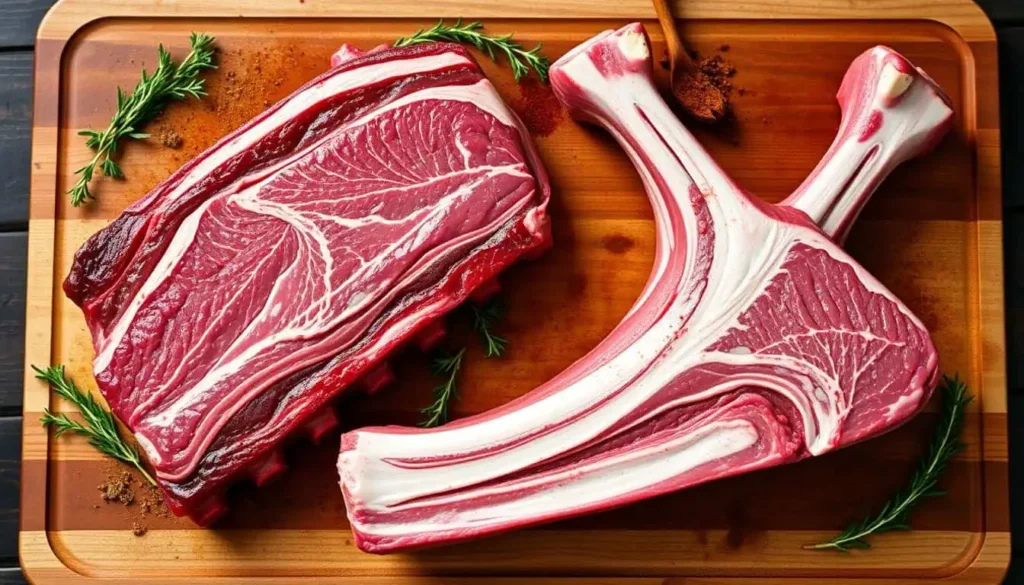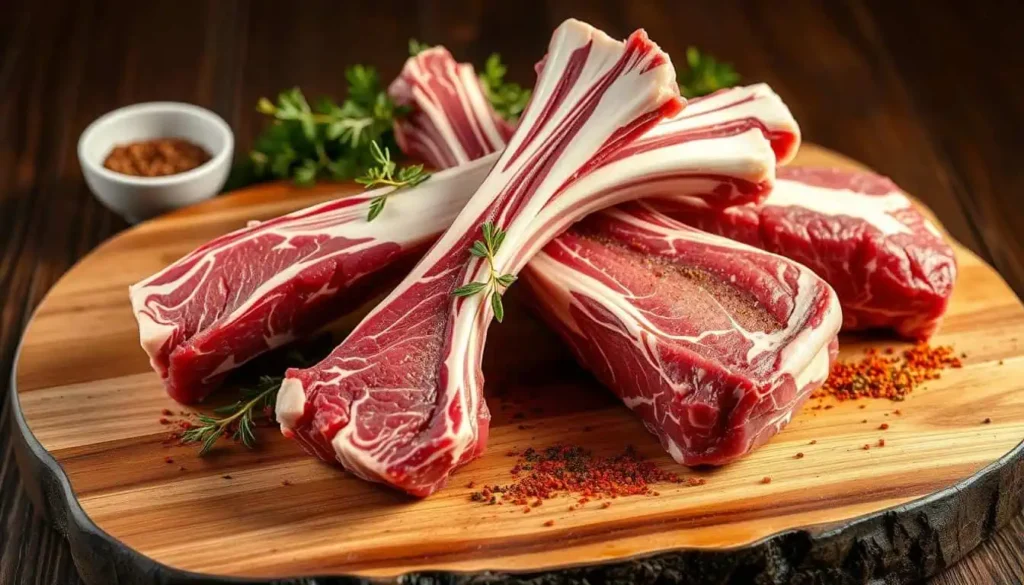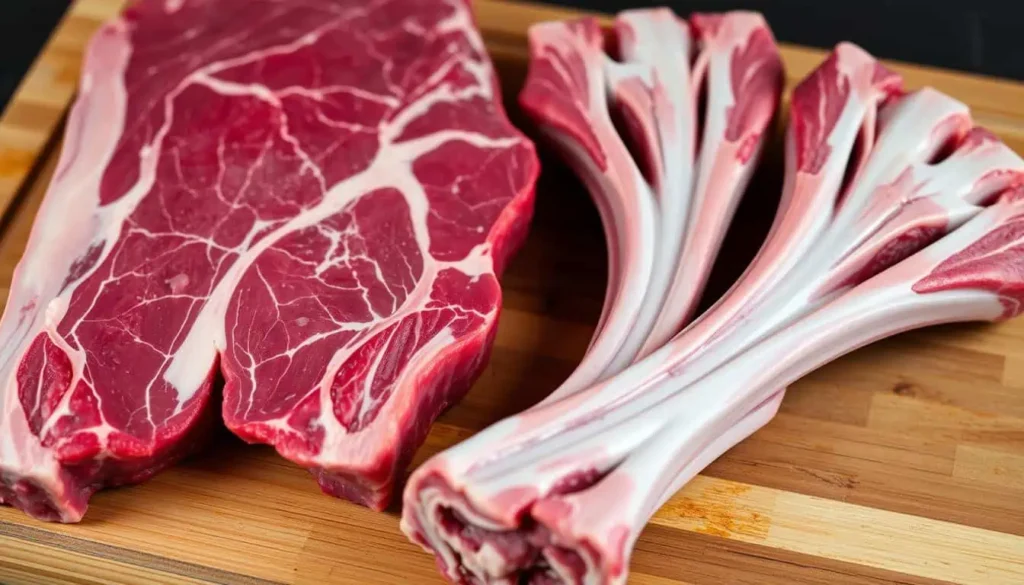Ever wondered if beef back ribs and prime rib bones are the same? This question pops up at family gatherings or when planning a barbecue. Both are known for their rich flavor and tender texture. But are they really the same in the kitchen? Let’s look into their differences and see which might be better for your next meal.
Key Takeaways
- Beef back ribs and prime rib bones come from different parts of the cow.
- Understanding these cuts ensures the right choice for cooking methods.
- Flavor profiles and textures differ between back ribs and prime rib bones.
- Each cut has unique culinary roles in various dishes.
- Cooking techniques vary, leading to different eating experiences.
Understanding the Basics of Beef Cuts
Exploring back ribs and prime rib bones led me to learn about rib cuts. The beef carcass is divided into sections, each with its own flavor and texture. This knowledge is key to understanding the differences.
For example, if you’re wondering about other rib cuts, you can explore whether beef back ribs are the same as beef ribs to learn more about the distinctions.
The main parts of beef include:
- Chuck – Great for stews and braising
- Rib – Home to both back ribs and prime ribs
- Loin – Known for tender cuts like steaks
- Round – Often used for roasts and ground beef
Knowing where back ribs and prime rib bones come from is important. Back ribs come from the rib primal section, offering unique flavors. Prime ribs, or rib roasts, come from the same area but are prepared differently. This knowledge helps us appreciate their distinct qualities.

What Are Beef Back Ribs?
Back ribs are a favorite for those who love meat. They come from the beef rib primal and are left over after the ribeye is cut out. The meat between and over the bones is generous, even if it’s not as thick as short ribs.
If you’re curious about trying new recipes with beef back ribs, check out this flavorful beef back ribs recipe for cooking inspiration.
Their connection to the ribeye adds a special flavor. This makes them a top choice for many.
The size of back ribs can vary. But they usually have enough meat for a big group. I find that slow cooking, like barbecuing, braising, or smoking, works best. These methods make the beef tender and juicy, bringing out its natural richness.
- Barbecued Back Ribs with a Sweet and Spicy Glaze
- Smoked Back Ribs with a Classic Rub
- Braised Back Ribs in Red Wine and Herbs
Exploring these cooking methods lets me find new ways to enjoy beef back ribs’ unique taste.
Want to know which cooking method works best? Learn more about the best cooking methods for back ribs to ensure tender, flavorful results.
What Are Prime Rib Bones?
Prime rib bones are a treat often found at special meals and fancy restaurants. They come from the rib section of a cow, keeping the tasty rib eye meat. You can get them with or without bones, depending on what you like.
These bones are known for being tender and full of flavor. They’re perfect for big events like holidays or family get-togethers. The meat’s marbling makes it juicy, which is why many people love it.
But prime rib bones are more than just a meal. After you’ve enjoyed the meat, you can use the bones to make delicious soups or stocks. This adds flavor to your meals even after the main course is gone.
This is different from beef back ribs, which come from another part of the cow. They have a unique texture and taste. Knowing the difference can make your dining experience even better and help you pick the right cut for your next meal.

Are beef back ribs the same as prime rib bones?
It’s important to know the difference between beef back ribs and prime rib bones. Both come from the beef carcass but have different cooking methods and tastes.
Defining the Cuts
Defining the Cuts:
- Beef Back Ribs: Come from the upper ribcage. They have less meat than prime rib bones.
- Prime Rib Bones: Come from a different part of the rib primal. They have a rich beefy flavor and lots of marbling.
The differences go beyond looks. The use and cooking methods for each cut are different too. Learn more about what beef back ribs are good for to understand their unique culinary roles.
Texture and Flavor Differences
Beef back ribs are tougher and need slow cooking to become tender. They have a robust flavor. Prime rib bones are tender and juicy, especially when roasted. They offer a more succulent taste.
When deciding if prime rib bones can replace beef back ribs, it’s clear. Each cut has its own cooking style and recipe. This suits its unique characteristics.
| Characteristics | Beef Back Ribs | Prime Rib Bones |
|---|---|---|
| Meat Quantity | Less meat, primarily bone | More meat, heavily marbled |
| Cooking Method | Slow-cooking, braising | Roasting, grilling |
| Texture | Tough, firm | Juicy, tender |
| Flavor | Robust, hearty | Rich, succulent |
Beef Back Ribs vs Prime Rib Bones: Key Differences
When comparing beef back ribs and prime rib bones, knowing their main differences is key. The source of the cuts greatly affects their characteristics. Beef back ribs come from the cow’s upper rib area, offering less meat than prime rib bones.
Prime rib bones, from the primal rib section, are known for their tenderness and rich flavor. They have more fat, making them juicy and perfect for roasting.
Flavor is another big difference. Beef back ribs have a strong taste that some love. Prime rib bones, on the other hand, are famous for their tender texture and rich flavor, great for special dinners.
| Aspect | Beef Back Ribs | Prime Rib Bones |
|---|---|---|
| Source | Upper rib area | Primal rib section |
| Meat Quantity | Less meat | More meat |
| Tenderness | Tougher | Succulent |
| Flavor Profile | Robust and hearty | Rich and juicy |
| Best Cooking Method | Slow braising or grilling | Roasting |
Knowing these differences helps me decide between beef back ribs and prime rib bones. Each cut brings something special to the table, fitting different tastes and cooking styles.
Similarities Between Prime Rib Bones and Beef Back Ribs
Exploring the similarities between prime rib bones and beef back ribs reveals a lot. Both cuts are known for their rich, beefy flavor. They come from the rib primal, adding a unique taste to any dish.
Cooking these cuts requires similar techniques. I often slow roast, braise, or barbecue them to get them tender. This makes them great for many recipes.
Understanding the similarities between these cuts helps me in the kitchen. Whether I pick beef back ribs or prime rib bones, I know I’ll get a tasty result.
Best Ways to Cook Beef Back Ribs and Prime Rib Bones
Choosing the right cooking method for beef back ribs and prime rib bones can greatly improve flavor and tenderness. Each cut needs a special approach to highlight its best qualities. I’m excited to share my top techniques for cooking these delicious meats, ensuring every bite is both flavorful and tender.
Cooking Techniques for Beef Back Ribs
For beef back ribs, slow cooking is key to render the fat and keep the meat juicy. Here are some of my favorite cooking tips for beef back ribs:
- Smoking: Smoke the ribs low and slow at around 225°F for several hours, allowing the smoky flavor to penetrate the meat.
- Grilling: Use indirect heat on the grill. Sear the ribs for a few minutes on each side, then move them to a cooler part of the grill.
- Braising: Cook ribs in a flavorful liquid for several hours in the oven. This method produces incredibly tender meat that falls off the bone.
Cooking Methods for Prime Rib Bones
Prime rib is a luxurious cut that deserves proper cooking techniques. Here are essential cooking tips for prime rib bones:
- Roasting: Start with a high oven temperature (around 450°F) to create a crust, then lower the temperature to finish cooking to your desired doneness.
- Reverse Searing: Cook the prime rib low and slow in the oven, then sear it in a hot skillet or grill for a short time before serving.
- Resting: Always allow the meat to rest for at least 20 minutes after cooking. This step ensures the juices redistribute throughout the meat, enhancing flavor.
By using these cooking techniques, anyone can master the art of preparing beef back ribs and prime rib bones. This will delight guests and family alike with delicious results.
| Cooking Method | Best For | Temperature |
|---|---|---|
| Smoking | Beef Back Ribs | 225°F |
| Grilling | Beef Back Ribs | Indirect heat |
| Braising | Beef Back Ribs | Low heat (varies) |
| Roasting | Prime Rib Bones | 450°F (then lower) |
| Reverse Searing | Prime Rib Bones | Low (then high heat) |
| Resting | Both Cuts | N/A |
Conclusion
My journey into the world of beef back ribs and prime rib bones has been enlightening. Each cut has its own special qualities. They both offer rich flavors and textures, but they’re used in different ways in cooking.
When deciding between prime rib bones and beef back ribs, it’s all about what I want to achieve. Both can make dishes delicious, but their unique tastes and textures matter a lot. How I cook and season them also affects the final taste, making the right choice crucial.
In the end, knowing about these cuts helps me improve my cooking. Whether I choose back ribs or prime rib bones, it’s about the experience I want to give. It’s not just about what’s available, but also the experience I want to share with others. Happy cooking!
FAQ
Are beef back ribs the same as prime rib bones?
No, they are not the same. Beef back ribs have less meat and are better for slow cooking. Prime rib bones, on the other hand, are juicier and tender, often with rib eye meat.
What are the key differences between back ribs and prime rib bones?
Beef back ribs are tougher and have more connective tissue. Prime rib bones are succulent and great for roasting. Their location in the rib primal also matters in cooking.
How should I cook beef back ribs?
Cook beef back ribs low and slow. Use methods like smoking, grilling, or braising. This makes them tender and flavorful.
What cooking techniques work well for prime rib bones?
Prime rib bones are best roasted. Try reverse searing for a nice crust and juicy meat inside.
Can you interchange beef back ribs with prime rib bones in recipes?
You can, but it depends on what you want. Beef back ribs have a unique taste and texture. Adjust cooking times and methods as needed.
What are the similarities between prime rib bones and beef back ribs?
Both come from the rib primal and taste rich in beef flavor. They need similar cooking methods like slow roasting or barbecuing for the best taste.
What’s the best way to buy prime rib bones or beef back ribs?
Choose quality meat from a trusted source. Look for freshness and marbling for flavor. Check local butchers or grocery stores for the best selection.
How can I ensure my beef back ribs are tender?
Use low and slow cooking for tenderness. Marinating them before cooking adds flavor and tenderizes the meat.
What are some good recipes for cooking beef back ribs?
Try classic barbecue ribs, smoked ribs, or braised ribs with a rich sauce. Each method highlights the meat’s unique flavors.
Is prime rib a good choice for special occasions?
Absolutely! Prime rib is luxurious and perfect for special events. Its tenderness and flavor make it a standout choice.

